admin
Staff member
The 2022 Kawasaki Z H2 & Z H2 SE: Stripped Down & Supercharged Hypernakeds
Contents
Look through the long list of Japanese motorcycles, and you’ll find plenty of naked bikes. But Kawasaki’s ambitious engineers have given a secret weapon to the Z H2 and its sibling bike, the Z H2 SE—namely, a 100% in-house designed and fully integrated supercharger. If that sounds like a game-changer, it’s because it is.
Kawasaki doesn’t mess around with their high-end bikes. This is a brand that always prioritizes performance, which the Z H2 and Z H2 SE prove beyond a shadow of a doubt. Both bikes feature a 998cc, liquid-cooled, 4-stroke, DOHC 16-valve in-line four engine that produces an absolutely whopping 194.4 hp @ 11,000 rpm and 101.1 lb-ft of torque @ 8,500 rpm. The balanced supercharger also puts the focus on low and mid-range power (although you can still enjoy the brand’s signature rush when you get up into higher revs).
For 2022, neither of these bikes have received notable performance or technology upgrades—but let’s be honest; they were already pretty much best-in-class bikes to begin with. Features include IMU-enhanced chassis orientation awareness, high-performance Showa suspension components, and Brembo brakes with M4.32 monobloc calipers. You also get electronic cruise control, multiple power modes, smartphone connectivity, and more.
To call this bike “feature rich” would be an understatement—it’s jam-packed. That makes it more than just the most elaborate naked bike in the 2022 Kawasaki lineup; it’s also one of the best naked bikes on the market today, giving rivals like the KTM 1290 Super Duke R a serious run for their money.
Speaking of money, the 2022 Kawasaki Z H2 starts at $18,000 USD / $20,299 CAD. It comes in Metallic Graphite Gray / Metallic Diablo Black. The SE model (which includes electronic suspension control and Showa skyhook technology) starts at $20,200 USD / $23,199 CAD and comes in Metallic Diablo Black / Golden Blazed Green.
On this page: we’ve curated specs, features, news, photos/videos, etc. so you can read up on the new 2022 Kawasaki Z H2 and Z H2 SE in one place.
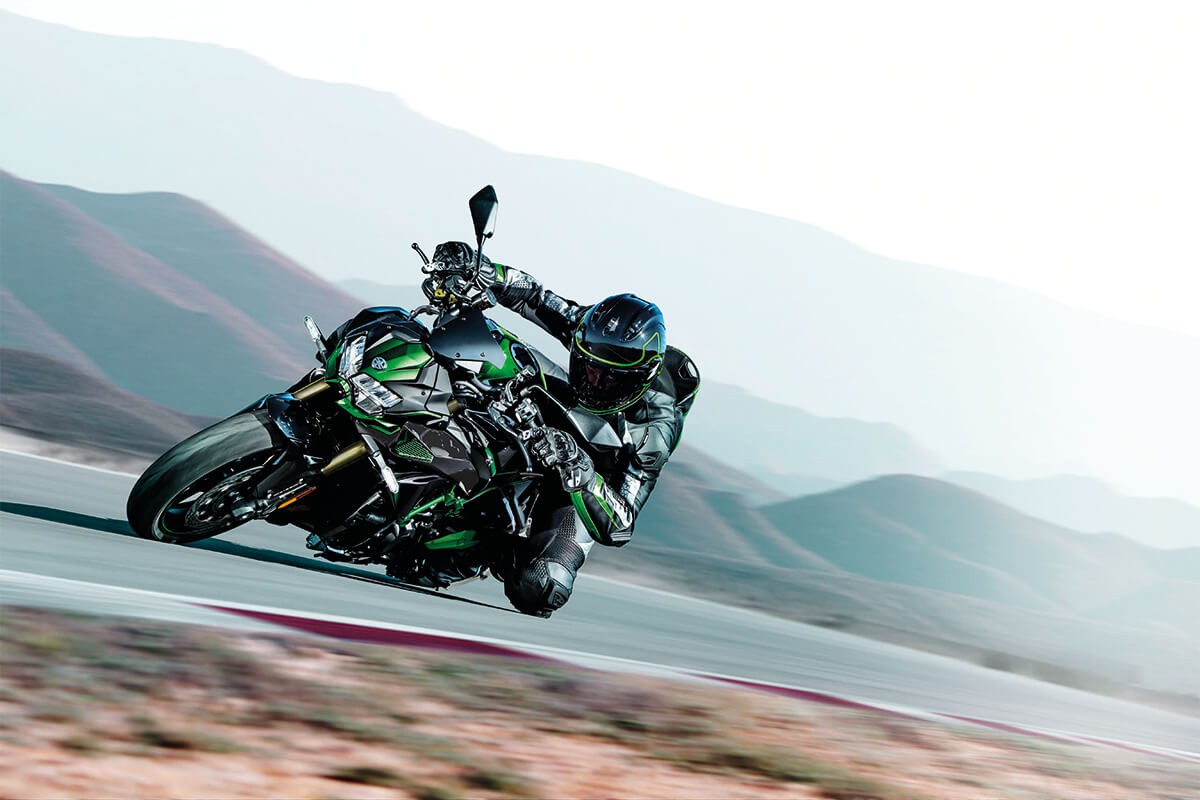
Model Overview
General Info
- Price:
- Z H2: $18,000 USD / $20,299 CAD
- Z H2 SE: $20,200 USD / $23,199 CAD
- Key Features:
- Supercharged engine
- Showa suspension (with Skyhook technology on the SE model)
- Brembo brake calipers
- Electronic cruise control & multiple power modes
Main Specs
- Engine: 998cc, liquid-cooled, 4-stroke, DOHC 16-valve in-line four
- Power: 194.4 hp @ 11,000 rpm
- Torque: 101.1 lb-ft of torque @ 8,500 rpm
- Curb Weight: 527 lbs (239 kg)
- Seat Height: 32.7 in (830mm)
Competitors
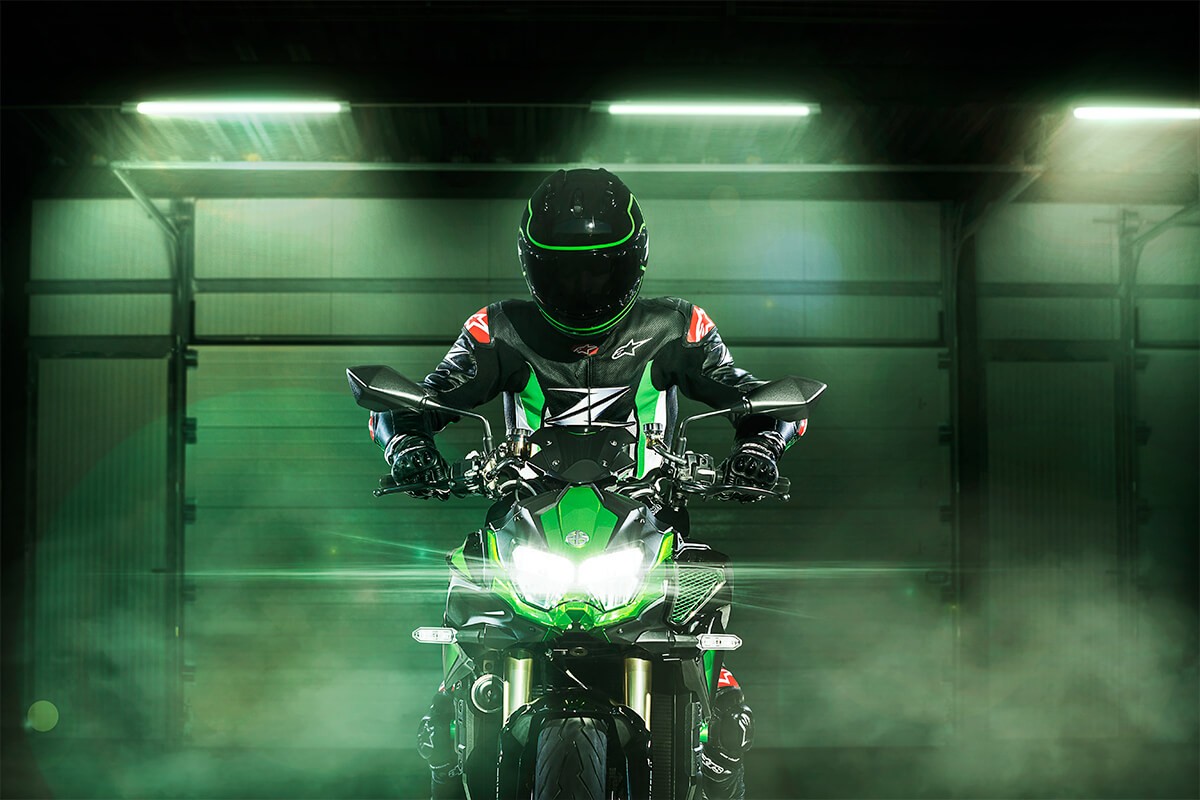
2022 Kawasaki Z H2 Specifications
ENGINE | |
| Engine | 998cc, 4-stroke, 4-cylinder, DOHC, 4-valve, liquid-cooled, supercharged |
| Power | 194.4 hp |
| Bore x Stroke | 76.0 x 55.0mm |
| Compression Ratio | 11.2:1 |
| Fuel System | DFI, 40mm Throttle Bodies |
| Starter | Electric |
| Lubrication | |
DRIVETRAIN | |
| Clutch | |
| Transmission | 6-speed, Manual, Return Shift, Dog Ring |
| Final Drive | Sealed chain |
CHASSIS | |
| Suspension Front | Showa SFF-BP Fork with Adjustable Compression and Rebound Damping, 20 Turns Spring Preload Adjustability / 4.7 in |
| Suspension Rear | Uni-Trak®, Showa Gas-Charged Shock with Adjustable Rebound Damping |
| Brakes Front | Dual 320mm Disc w/Radial-mount Brembo M4.32 Calipers, KIBS |
| Brakes Rear | Single 250mm disc with single-piston caliper, KIBS |
| Tires Front | 120/70-17 |
| Tires Rear | Single 260mm disc with single-piston caliper, KIBS |
| Fuel Tank Capacity | 5.0 gal |
| Color | Metallic Graphite Gray/Metallic Diablo Black |
ELECTRICAL | |
| Ignition | TCBI w/ Digital Advance |
| Spark Plugs | |
| Headlight | LED |
| Tail Light | LED |
DIMENSIONS | |
| Overall Length | 82.1 in |
| Overall Width | 31.9 in |
| Overall Height | 44.5 in |
| Wheelbase | 57.3 in |
| Ground Clearance | 5.5 in |
| Seat Height | 32.7 in |
| Curb Weight | 529.2 lb* |
WARRANTY | |
| Warranty | 12 Months |
| Kawasaki Protection Plus | 12, 24, or 36 months |
2022 Kawasaki Z H2 SE Specifications
ENGINE | |
| Engine | 998cc, 4-stroke, 4-cylinder, DOHC, 4-valve, liquid-cooled, supercharged |
| Power | 194.4 hp |
| Bore x Stroke | 76.0 x 55.0mm |
| Compression Ratio | 11.2:1 |
| Fuel System | DFI, 40mm Throttle Bodies |
| Starter | Electric |
| Lubrication | |
DRIVETRAIN | |
| Clutch | |
| Transmission | 6-speed, Manual, Return Shift, Dog Ring |
| Final Drive | Sealed chain |
CHASSIS | |
| Suspension Front | Showa SFF-BP Fork with KECS Compression and KECS Rebound Damping, plus Manual Spring Preload Adjustability |
| Suspension Rear | Uni-Trak®, Showa Gas-Charged Shock with KECS Compression and KECS Damping, plus Manual Spring Preload Adjustability |
| Brakes Front | Dual 320mm Disc w/Radial-mount Brembo M4.32 Calipers, KIBS |
| Brakes Rear | Single 250mm disc with single-piston caliper, KIBS |
| Tires Front | 120/70-17 |
| Tires Rear | 190/55-17 |
| Fuel Tank Capacity | 5.0 gal |
| Color | Metallic Diablo Black/Golden Blazed Green |
ELECTRICAL | |
| Ignition | TCBI w/ Digital Advance |
| Spark Plugs | |
| Headlight | LED |
| Tail Light | LED |
DIMENSIONS | |
| Overall Length | 82.1 in |
| Overall Width | 31.9 in |
| Overall Height | 44.5 in |
| Wheelbase | 57.3 in |
| Ground Clearance | 5.5 in |
| Seat Height | 32.7 in |
| Curb Weight | 531.4 lb* |
WARRANTY | |
| Warranty | 12 Months |
| Kawasaki Protection Plus | 12, 24, or 36 months |
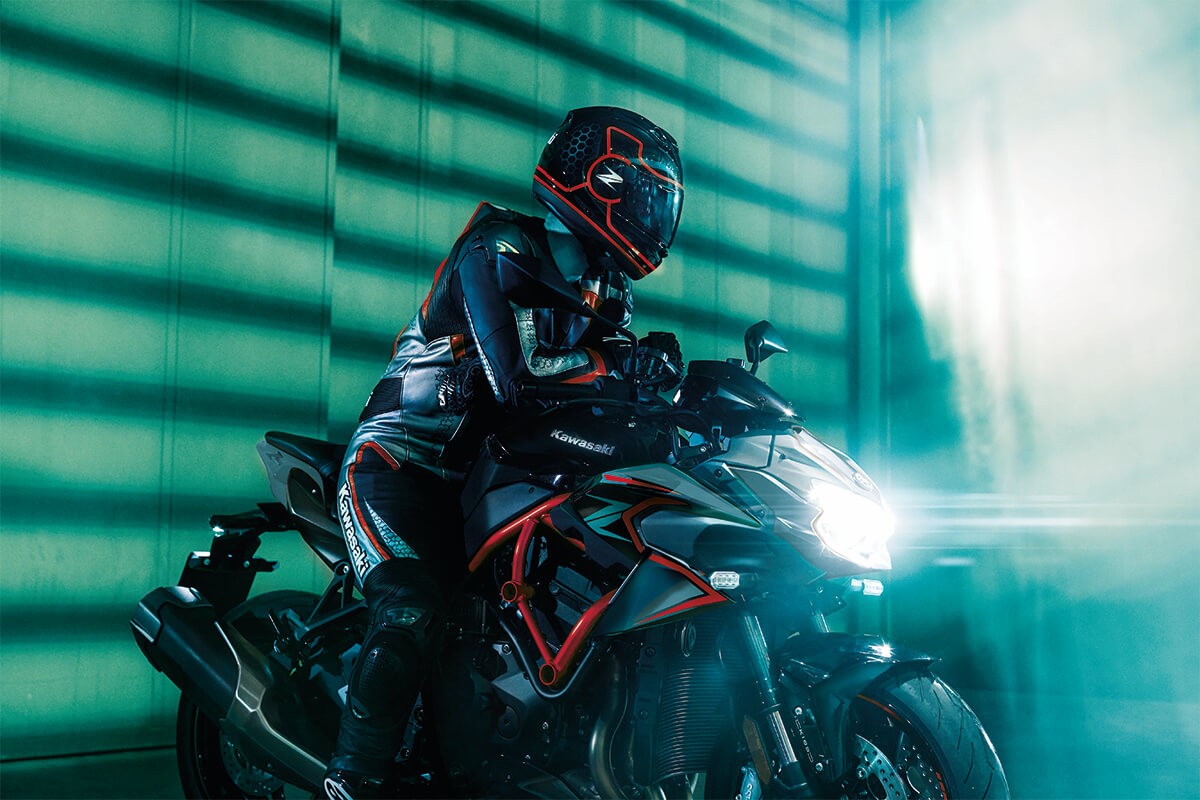
2022 Kawasaki Z H2 & Z H2 SE Features
Assist & Slipper Clutch
Based on feedback from racing activities, the Assist & Slipper Clutch uses two types of cams (an assist cam and a slipper cam) to either drive the clutch hub and operating plate together or apart.Under normal operation, the assist cam functions as a self-servo mechanism, pulling the clutch hub and operating plate together to compress the clutch plates. This allows the total clutch spring load to be reduced, resulting in a lighter clutch lever feel when operating the clutch.
When excessive engine braking occurs – as a result of quick downshifts (or an accidental downshift) – the slipper cam comes into play, forcing the clutch hub and operating plate apart. This relieves pressure on the clutch plates to reduce back-torque and helps prevent the rear tire from hopping and skidding. This race-style function is particularly useful when sport or track riding.
Economical Riding Indicator
Using high-precision electronic control for engine management, Kawasaki models can achieve a high level of fuel efficiency. However, fuel consumption is greatly affected by throttle use, gear selection, and other elements under the rider’s control. The Economical Riding Indicator is a function that indicates when current riding conditions are consuming a low amount of fuel. The system continuously monitors fuel consumption, regardless of vehicle speed, engine speed, throttle position and other riding conditions. When fuel consumption is low for a given speed (i.e. fuel efficiency is high), an “ECO” mark appears on the instrument panel’s LCD screen. By riding so that the “ECO” mark remains on, fuel consumption can be reduced.While effective vehicle speed and engine speed may vary by model, paying attention to conditions that cause the “ECO” mark to appear can help riders improve their fuel efficiency – a handy way to increase cruising range. Further, keeping fuel consumption low also helps minimize negative impact on the environment.
Electronic Cruise Control
Electronic Cruise Control allows a desired speed (engine rpm) to be maintained with the simple press of a button. Once activated, the rider does not have to constantly apply the throttle. This reduces stress on the right hand when traveling long distances, enabling relaxed cruising and contributing to a high level of riding comfort.Electronic Throttle Valves
Kawasaki’s fully electronic throttle actuation system enables the ECU to control the volume of both the fuel (via fuel injectors) and the air (via throttle valves) delivered to the engine. Ideal fuel injection and throttle valve position results in smooth, natural engine response and the ideal engine output. The system also makes a significant contribution to reduced emissions.Electronic throttle valves also enable more precise control of electronic engine management systems like S-KTRC and KTRC, and allow the implementation of electronic systems like KLCM, Kawasaki Engine Brake Control, and Electronic Cruise Control.
KLCM (Kawasaki Launch Control Mode)
Designed to assist riders by optimizing acceleration from a stop, KLCM electronically manages engine output to minimize wheel spin when moving off. With the clutch lever pulled in and the system activated, engine speed is limited to a determined speed while the rider holds the throttle open. Once the rider releases the clutch lever to engage the clutch, engine speed is allowed to increase, but power is regulated to minimize wheel spin and help keep the front wheel on the ground. The system disengages automatically once a predetermined speed has been reached, or when the rider shifts into third gear. Depending on the model, riders can choose from multiple modes, each offering a progressively greater level of intrusion.KCMF (Kawasaki Cornering Management Function)
Using the latest evolution of Kawasaki’s advanced modeling software and feedback from a compact IMU (Inertial Measurement Unit) that gives an even clearer real-time picture of chassis orientation, KCMF monitors engine and chassis parameters throughout the corner – from entry, through the apex, to corner exit – modulating brake force and engine power to facilitate smooth transition from acceleration to braking and back again, and to assist riders in tracing their intended line through the corner. The systems that KCMF oversees vary by model, but may include:Dual Throttle Valves
Late-model sport bikes often use large-bore throttle bodies to generate high levels of power. However, with large diameter throttles, when a rider suddenly opens the throttle, the unrestricted torque response can be strong. Dual throttle valve technology was designed to tame engine response while contributing to performance.On models with dual throttle valves, there are two throttle valves per cylinder: in addition to the main valves, which are physically linked to the throttle grip and controlled by the rider, a second set of valves, opened and closed by the ECU, precisely regulates intake airflow to ensure a natural, linear response. With the air passing through the throttle bodies becoming smoother, combustion efficiency is improved and power is increased.
KTRC (Kawasaki Traction Control)
KTRC, Kawasaki’s advanced traction control system provides both enhanced sport riding performance and the peace of mind to negotiate slippery surfaces with confidence. Multiple rider-selectable modes (the number of modes varies by model) offer progressively greater levels of intrusion to suit the riding situation and rider preference.Less intrusive modes maintain optimum traction during cornering. Designed with sport riding in mind, they facilitate acceleration out of corners by maximizing forward drive from the rear wheel. And because Kawasaki’s sophisticated software bases its dynamic analysis on the chassis’ orientation relative to the track surface (rather than relative to a horizontal plane), it is able to take into account corner camber, gradient, etc., and adapt accordingly.
In the more intrusive modes (and for some models, in any mode), when excessive wheel spin is detected, engine output is reduced to allow grip to be regained, effectively enabling riders to negotiate both short, slippery patches (train tracks or manhole covers) and extended stretches of bad roads (wet pavement, cobblestone, gravel) with confidence.
Power Modes
Models equipped with multiple Power Modes offer riders an easily selectable choice of engine power delivery to suit riding conditions or preference. In addition to Full Power mode, one (Low) or two (Middle, Low) alternate mode(s) in which maximum power is limited and throttle response is milder are provided.Sound Tuning
Kawasaki has long had a reputation for building great-sounding bikes – a characteristic inherent in the Kawasaki engine architecture – but it is only recently that effort has been put into crafting a specific auditory experience through careful sound tuning of either the intake or exhaust system.Designed specifically to allow riders to enjoy their motorcycles aurally as well as physically, the carefully crafted auditory notes can be the key components of the street riding exhilaration offered by models that have benefitted from sound tuning. Sound tuning can include conducting sound research, designing intake and exhaust system components based on an acoustic test carried out in a sound room, and careful consideration of every detail of a system’s components to ensure a balance of performance and the desired sound.
Supercharged Engine
Drawing on the know-how and technology possessed by the Kawasaki Heavy Industries, Ltd. (KHI), Kawasaki’s supercharged engine delivers high engine output while maintaining a compact design. The key to achieving this incredible performance lies in the engine’s supercharger – a motorcycle-specific unit designed completely in-house with technology from the Kawasaki Gas Turbine & Machinery Company, Aerospace Company and Corporate Technology Division.One of the greatest benefits of designing the supercharger in-house and tailoring its design to match the engine’s characteristics was that engineers were able to achieve high-efficiency operation over a wide range of conditions – something that would not have been possible by simply dropping in or trying to adapt an aftermarket automotive supercharger.
The importance of high efficiency in a supercharger is that, as the air is compressed, power-robbing heat gain is minimal. And while many superchargers are able to offer high-efficiency operation in a very limited range of conditions, the Kawasaki supercharger offers high efficiency over a wide range of pressure ratios and flow rates – meaning over a wide range of engine speeds and vehicle speeds. This wide range of efficient operation (similar to having a wide power band) easily translates to strong acceleration. The supercharger’s high efficiency and minimal heat gain also meant that an intercooler was unnecessary, greatly saving weight and space, and enabling the engine’s compact design.
KQS (Kawasaki Quick Shifter)
Designed to help riders maximize their acceleration on the track by enabling clutchless upshifts with the throttle fully open, KQS detects that the shift lever has been actuated and sends a signal to the ECU to cut ignition so that the next gear can be engaged without having to use the clutch. On models that offer clutchless downshifts, during deceleration the system automatically controls engine speed so that the next lower gear can be selected without operating the clutch.ABS (Anti-lock Brake System)
Kawasaki ABS systems use front and rear wheel sensors to constantly monitor wheel speed. Should information from either of the sensors indicate that wheel lock has occurred, the ABS ECU directs the pump in the ABS unit to modulate brake fluid pressure (releasing and reapplying pressure so that traction can be regained) until normal operation resumes. ABS offers rider reassurance that contributes to greater riding enjoyment.IMU-Enhanced Chassis Orientation Awareness
The strength of Kawasaki’s cutting-edge electronics has always been the highly sophisticated programming that, using minimal hardware, gives the ECU an accurate real-time picture of what the chassis is doing. Kawasaki’s proprietary dynamic modeling program makes skillful use of the magic formula tire model as it examines changes in multiple parameters, enabling it to take into account changing road and tire conditions.The addition of an IMU (Inertial Measurement Unit) enables inertia along 6 DOF (degrees of freedom) to be monitored. Acceleration along longitudinal, transverse and vertical axes, plus roll rate and pitch rate are measured. The yaw rate is calculated by the ECU using Kawasaki original software. This additional feedback contributes to an even clearer real-time picture of chassis orientation, enabling even more precise management for control at the limit.
KECS (Kawasaki Electronic Control Suspension)
KECS adapts to road and riding conditions in real time, providing the ideal amount of damping called for by electronically adjusting damping to suit vehicle speed and suspension stroke speed. Deceleration is also taken into account, which allows the system to help manage pitching that may occur during braking.Control via solenoid valve with direct actuation enables an extremely quick reaction time, making KECS ideal for sport riding applications, where natural feeling is crucial to feeling at one with the bike. Built-in stroke sensors on both the fork and rear shock provide real-time stroke speed and compression information. Input from the sensor coils to the KECS ECU is complemented by information provided by the IMU (acceleration/deceleration) and the FI ECU (vehicle speed). The KECS ECU then directs current to the solenoids to adjust damping as required by the situation.
2022 Kawasaki Z H2 & Z H2 SE Photos

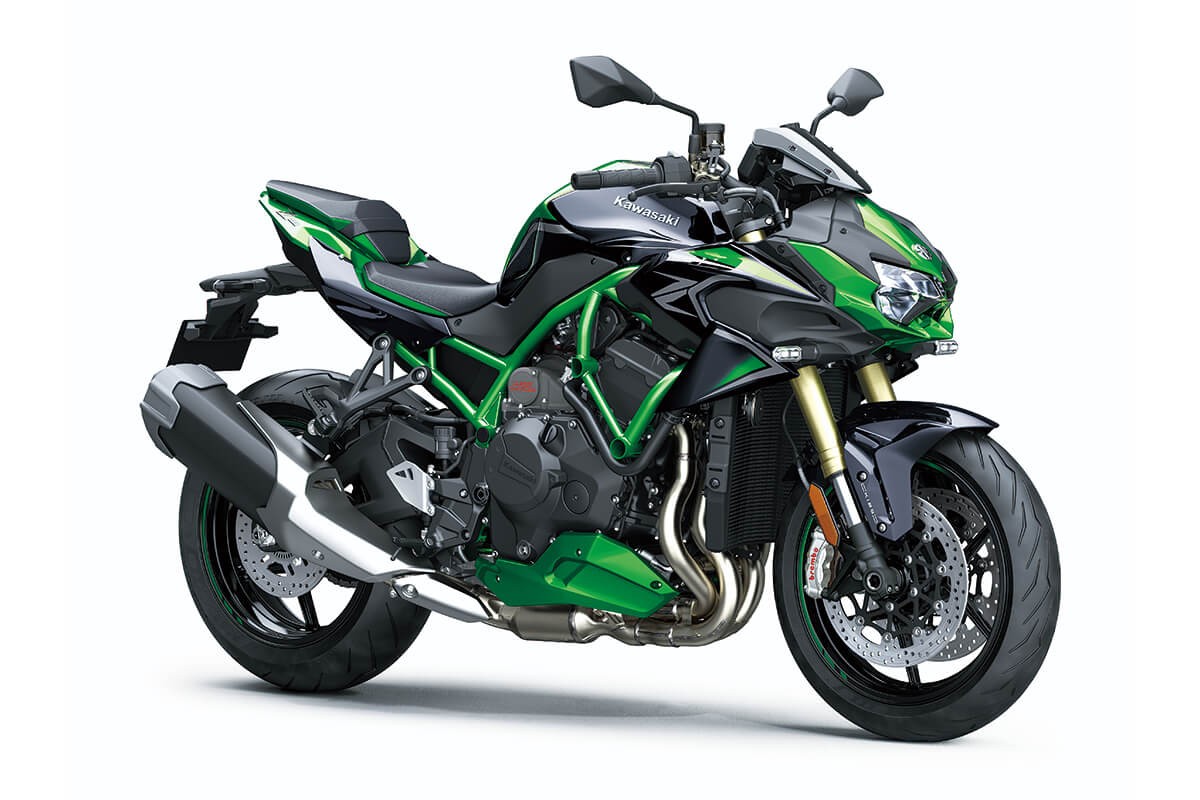
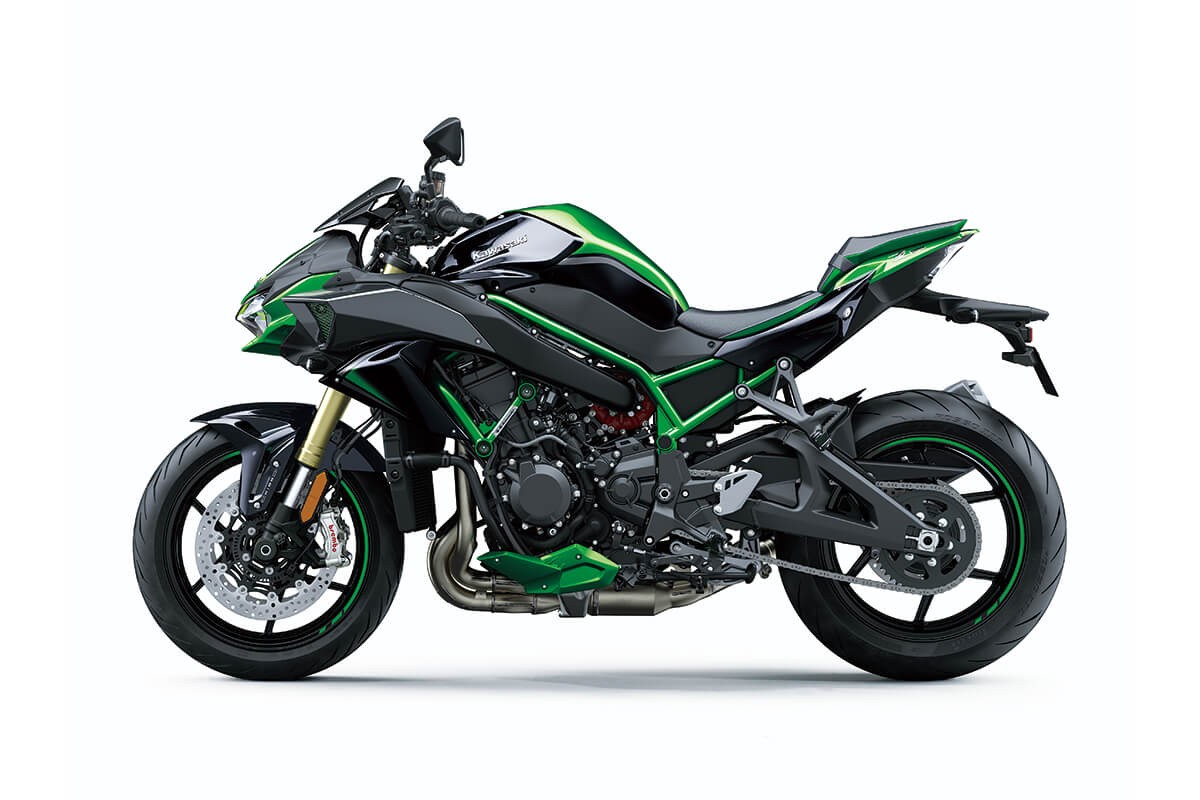
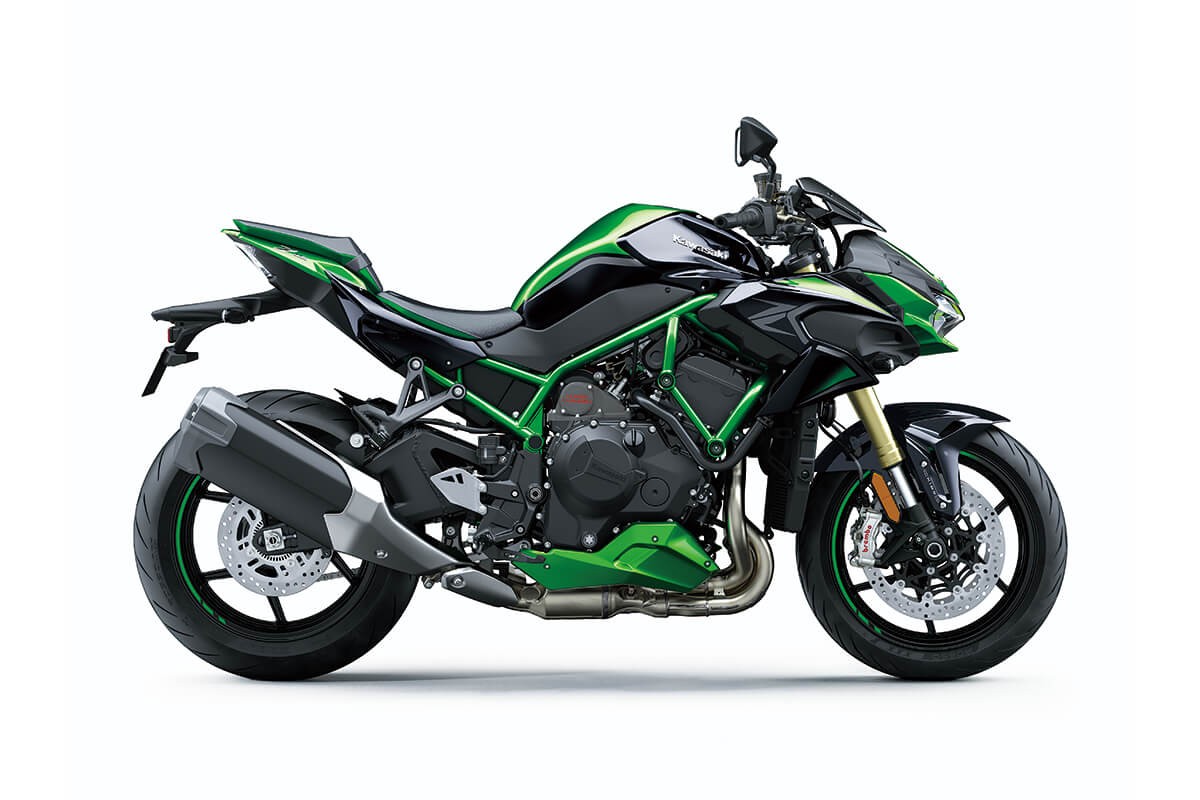
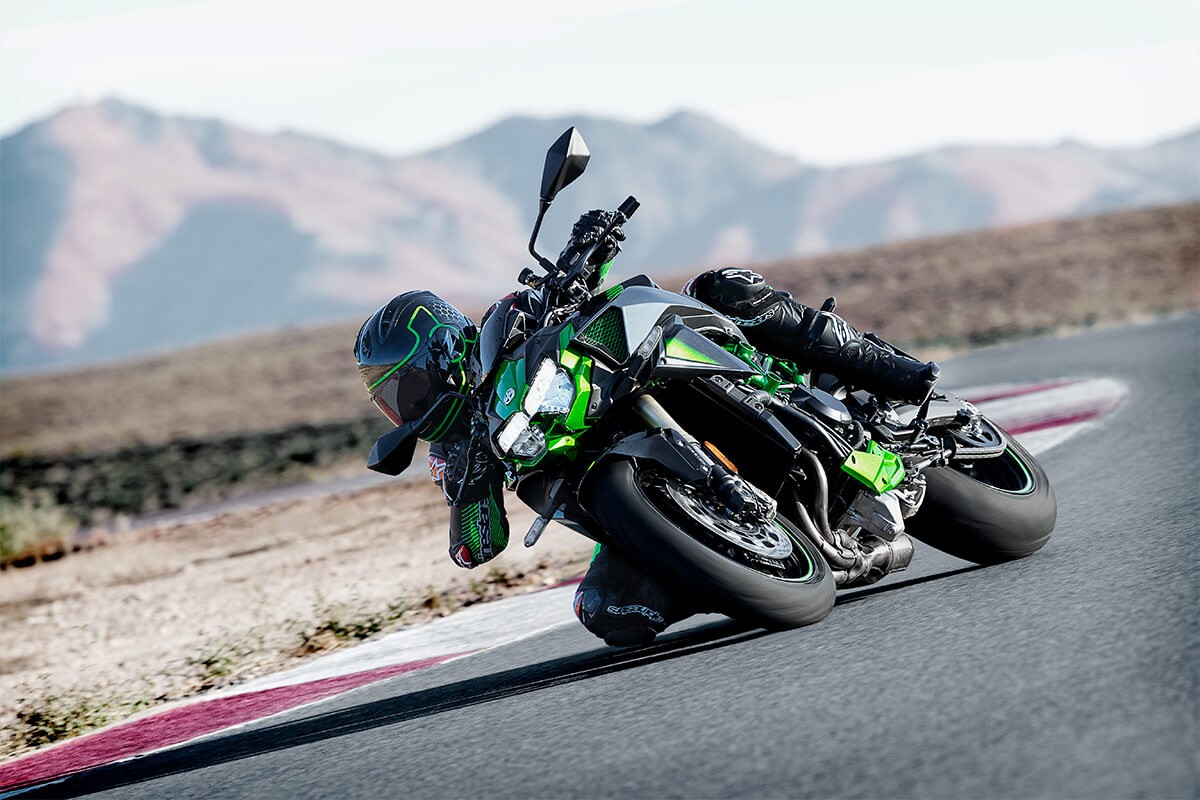
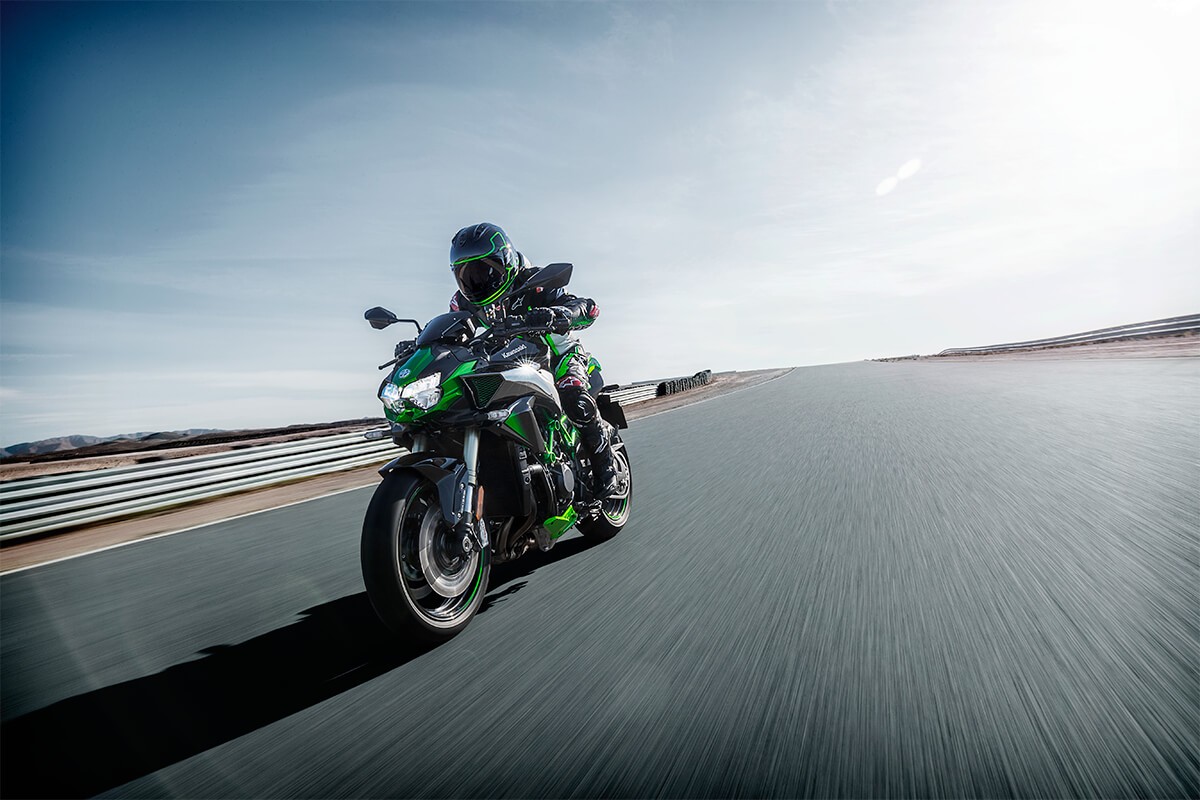
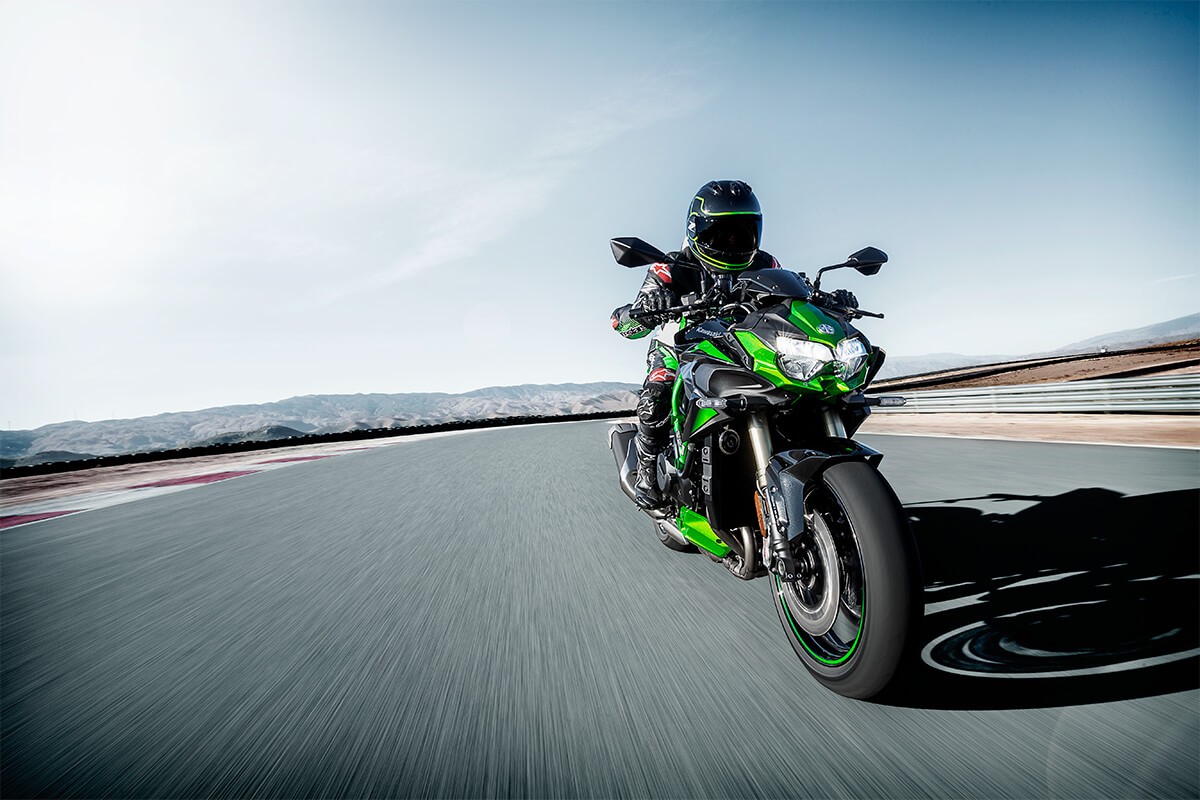
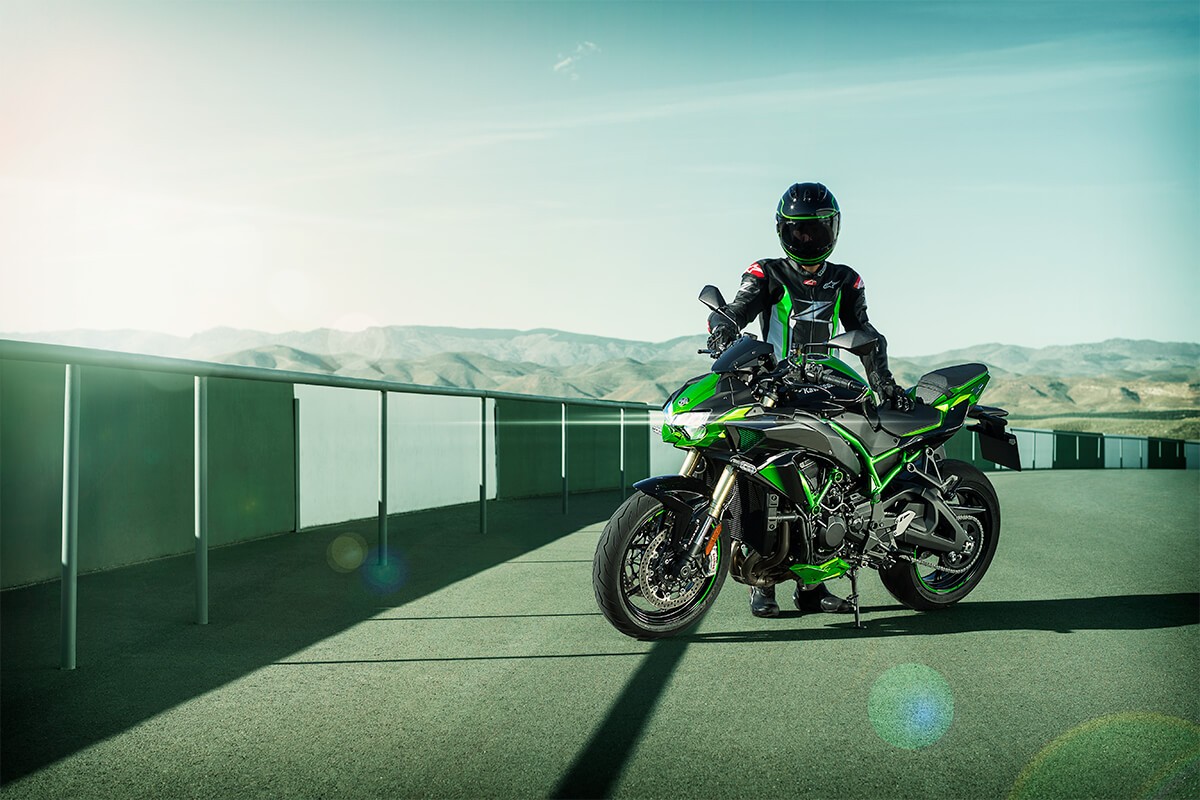

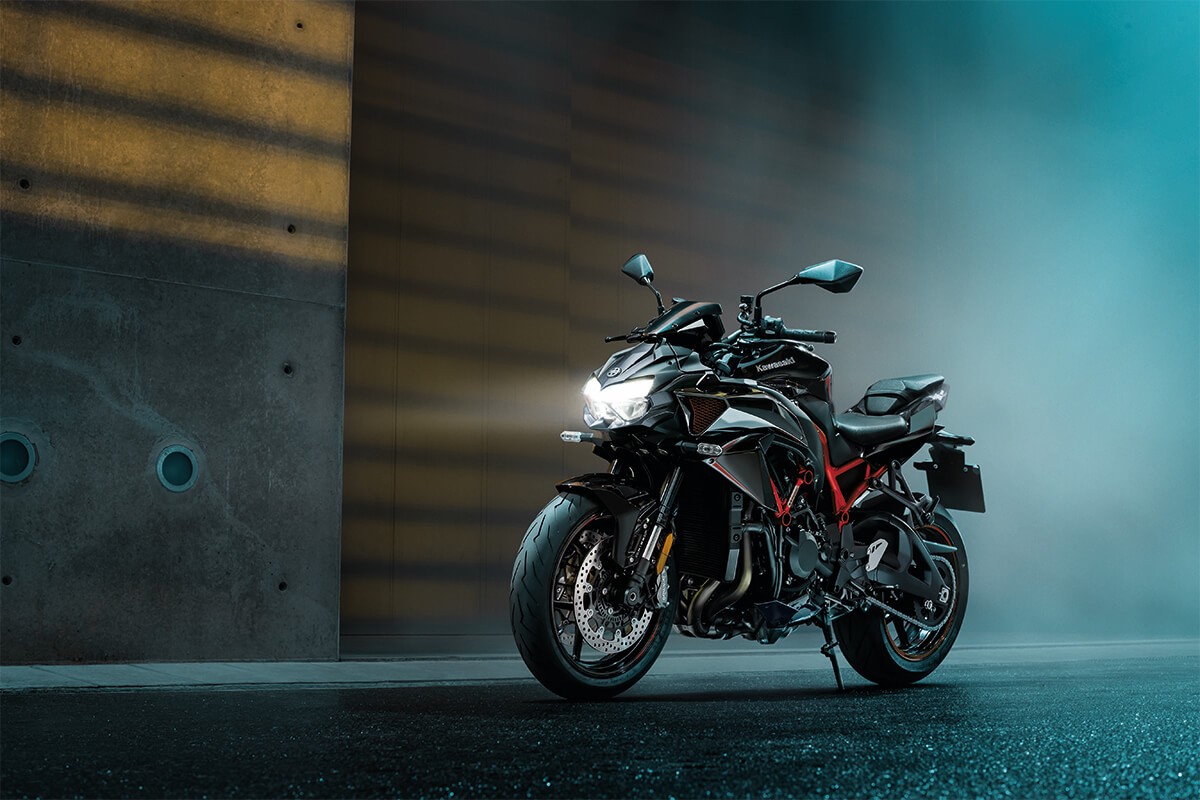


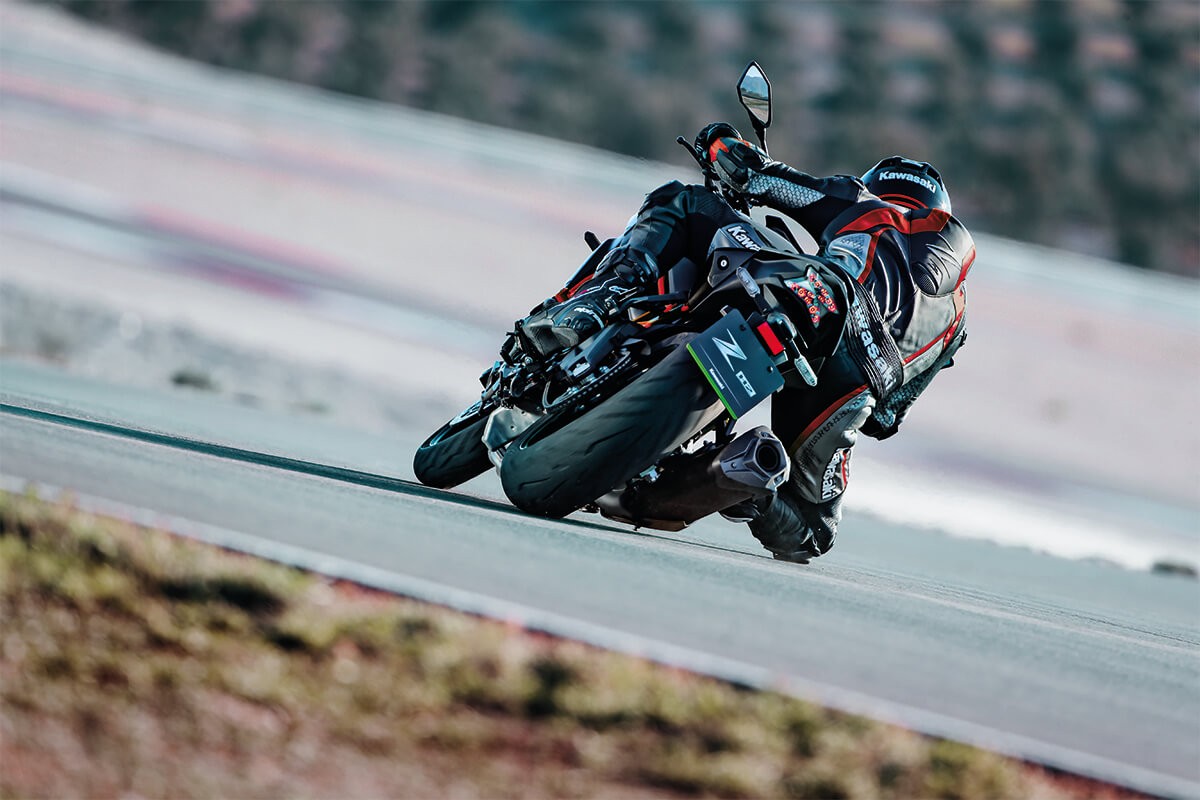
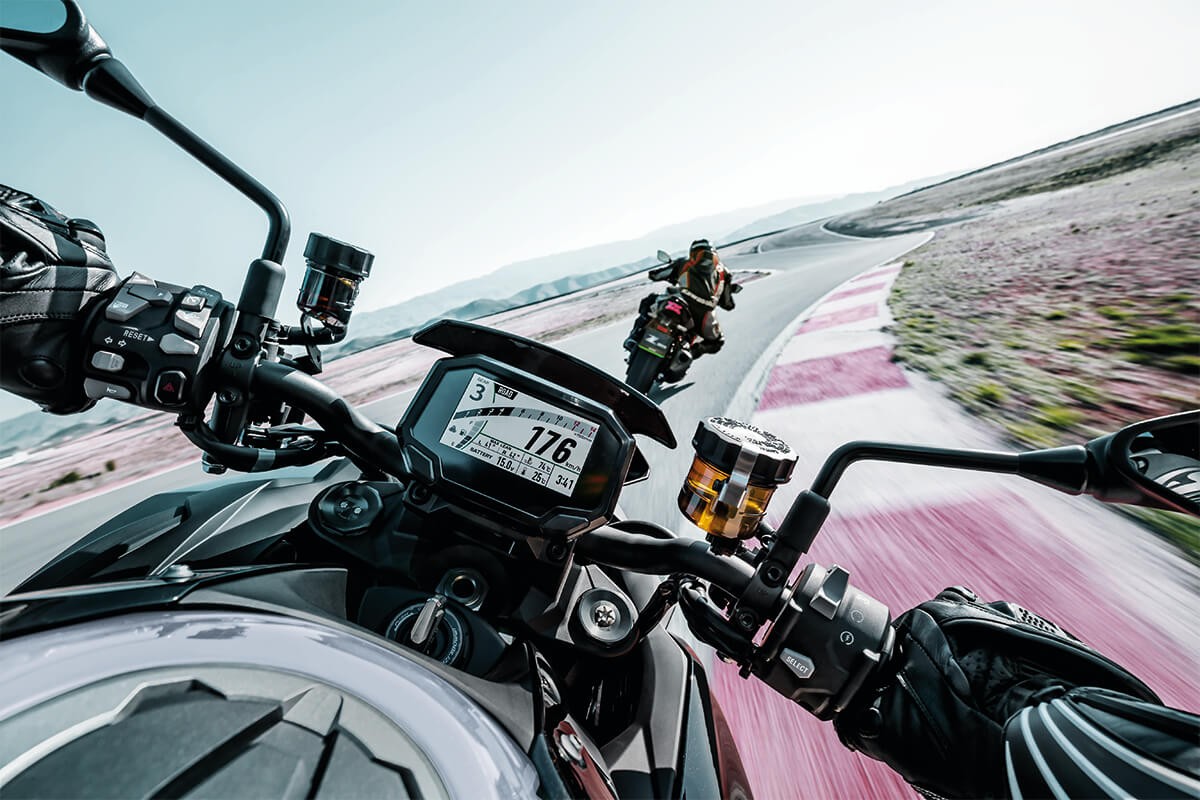
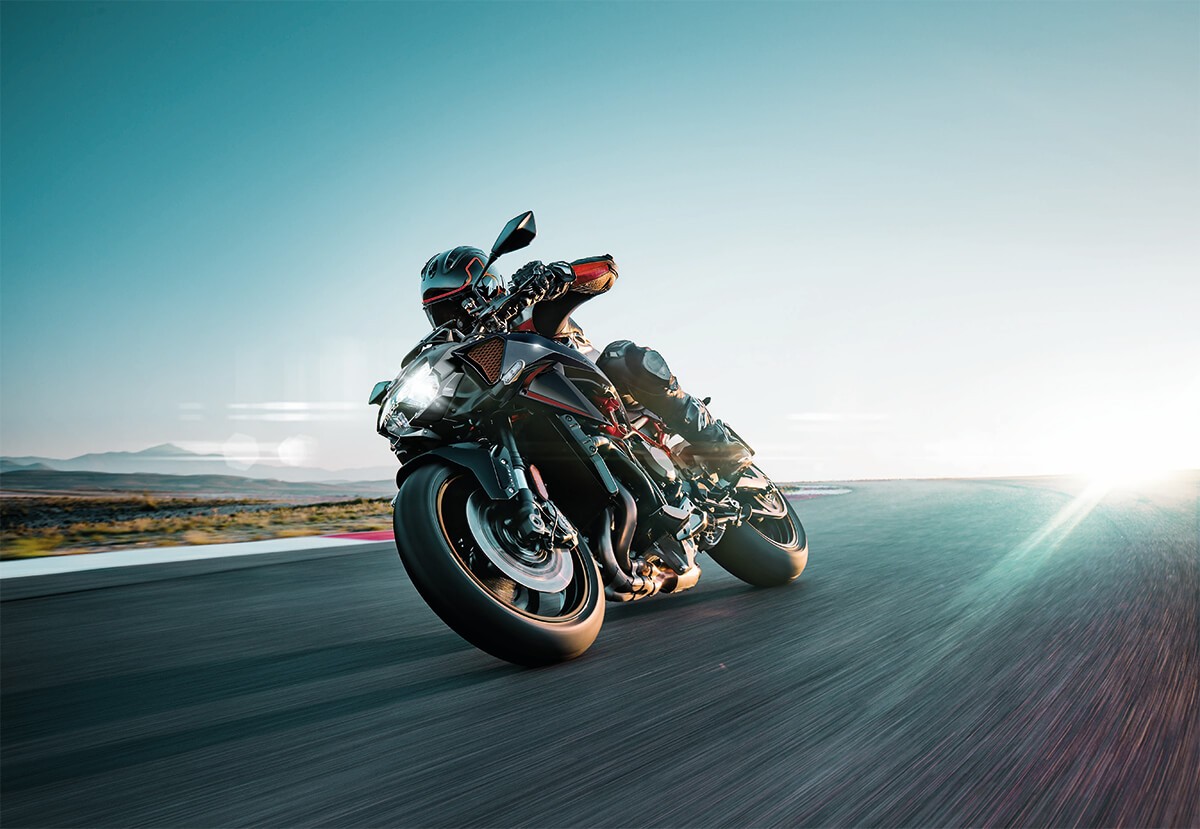

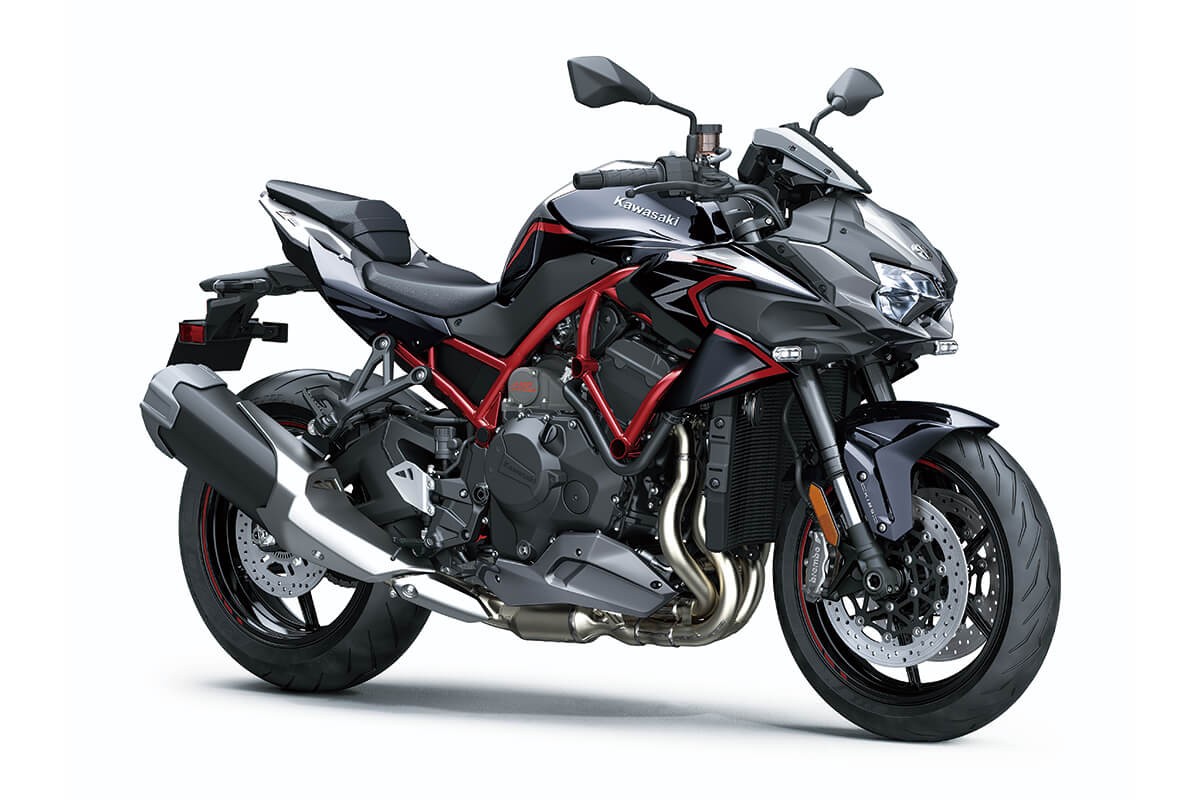
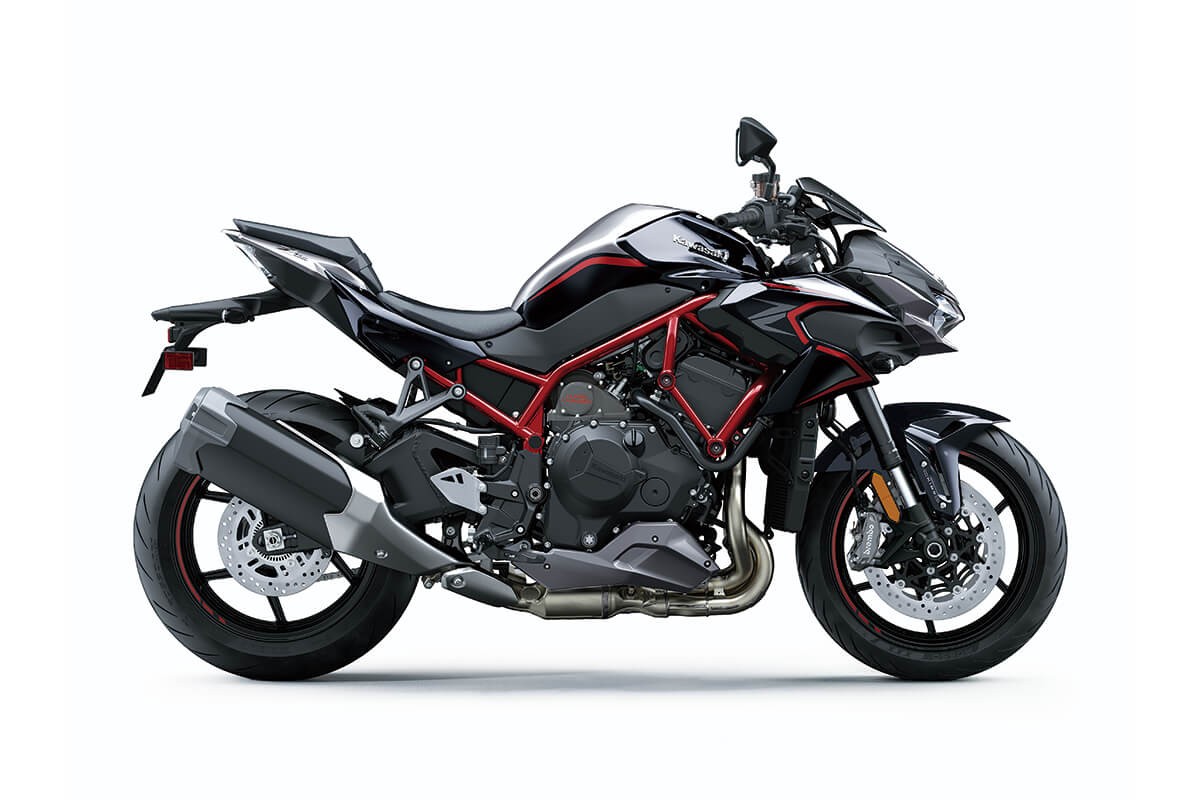
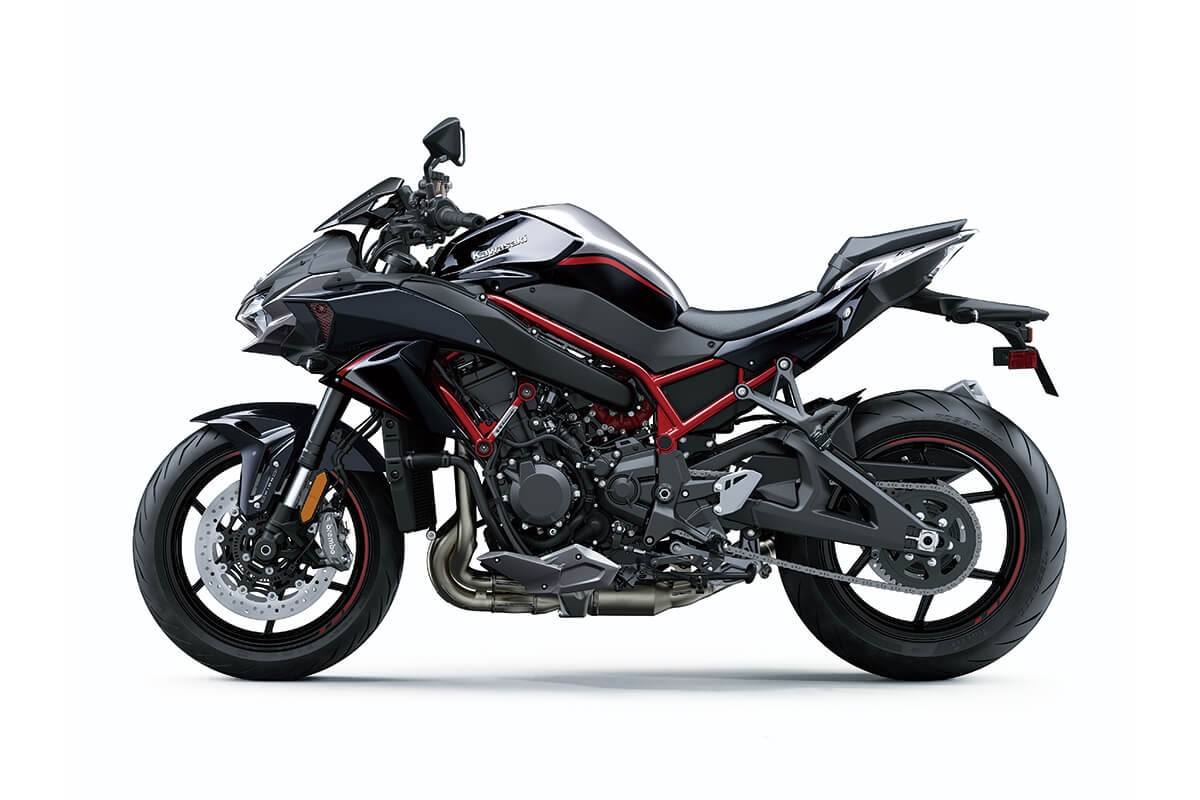
2022 Kawasaki Z H2 & Z H2 SE Videos
2022 Kawasaki Z H2 SE The Bare Facts | Price & Spec Details
Kawasaki ZH2 2022 | First ride and review of a supercharged monster!
Links
Kawasaki Official Websites
Social Media Links
The post 2022 Kawasaki Z H2 & Z H2 SE [Specs, Features, Photos] appeared first on webBikeWorld.
Continue reading...


